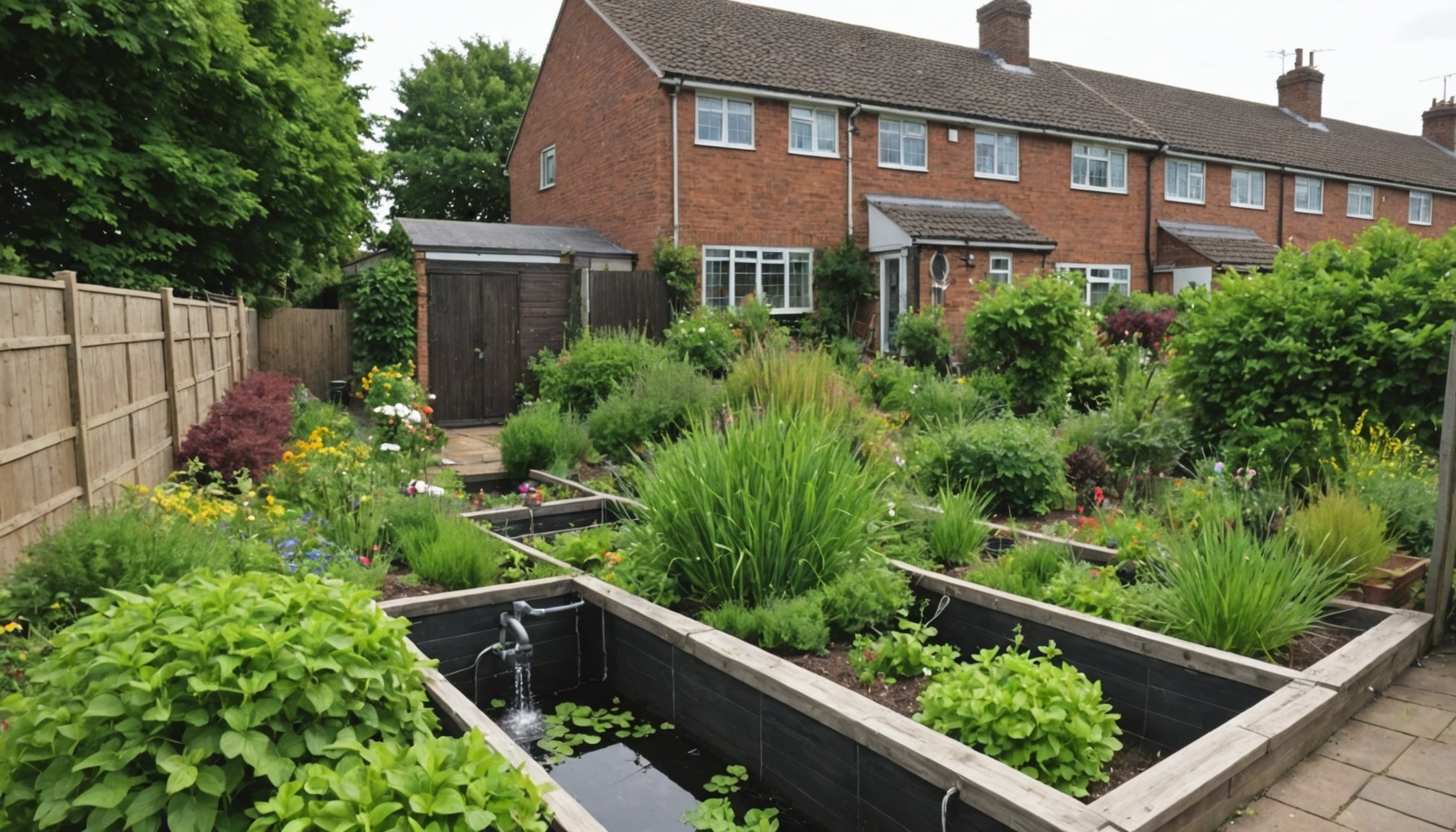Greywater offers an innovative solution for sustainable gardening in UK suburbs. By recycling water from baths, sinks, and washing machines, you can nurture your garden while conserving precious resources. This guide explores practical methods to harness greywater effectively, debunking myths and providing easy instructions. Embrace eco-friendly practices that not only enhance your garden but also contribute to a healthier environment. Discover how simple changes can lead to a flourishing, sustainable garden that benefits both you and the planet.
Benefits of Using Greywater in Sustainable Gardening
Incorporating greywater systems into your gardening routine offers several environmental advantages. By reusing water from sinks, showers, and washing machines, you significantly reduce the demand on local water supplies. This practice aligns with eco-friendly practices as it minimizes the strain on freshwater resources and decreases the amount of wastewater entering the sewage system.
Lire également : Transform Your Garden: Achieve a Charming Rustic Aesthetic Using Recycled Farm Materials from the UK!
From a financial perspective, greywater systems can lead to substantial cost savings. By reusing water that would otherwise be wasted, households can lower their water bills. This is particularly beneficial in areas where water is scarce or expensive, making greywater an economically viable solution for sustainable gardening.
Moreover, using greywater can contribute to improved plant health. The nutrients present in greywater, such as phosphorus and nitrogen, can act as natural fertilizers, promoting healthier plant growth. Additionally, greywater usage supports water conservation, allowing gardeners to maintain lush landscapes even in drought-prone regions. By implementing greywater systems, gardeners not only support a more sustainable environment but also enjoy the practical benefits of reduced costs and enhanced plant vitality.
Sujet a lire : City Chickens: How to Raise Them in Your UK Garden Without Upsetting the Neighbors
Techniques for Collecting and Distributing Greywater
Understanding greywater collection methods is essential for integrating this sustainable practice into your gardening routine. At home, simple methods such as diverting water from sinks and showers using a bucket can be an effective start. For a more permanent solution, installing a diverter valve in plumbing systems allows for the redirection of greywater to storage tanks or directly to the garden.
When it comes to distribution systems, gardeners have several options to ensure efficient water use. Subsurface irrigation systems, for instance, distribute greywater directly to the plant roots, minimizing evaporation and maximizing absorption. Alternatively, drip irrigation systems can be adapted to utilize greywater, providing a controlled water supply that reduces waste.
For those interested in a hands-on approach, creating a DIY greywater solution can be both rewarding and cost-effective. Begin by identifying the sources of greywater in your home, such as the bathroom sink or washing machine. Install a basic filtration system to remove larger particles, ensuring that the water is safe for plants. Next, set up a simple piping system to direct the filtered greywater to your garden. By following these steps, you can create a sustainable and efficient greywater system tailored to your gardening needs.
Legal Considerations for Greywater Use in the UK
Navigating the greywater regulations in the UK is crucial for gardeners aiming to incorporate sustainable practices legally. The UK gardening laws regarding greywater use are designed to ensure environmental safety and public health. Generally, the use of greywater for irrigation is permitted, provided it does not pose a risk to the environment or human health. However, it is essential to be aware of specific legal guidelines that may apply in your area.
Overview of UK Legislation Regarding Greywater Use
In the UK, greywater systems must comply with the Water Supply (Water Fittings) Regulations 1999. These regulations stipulate that any system must prevent contamination of the mains water supply. It is also important to note that while domestic greywater use is generally allowed, commercial applications may require further scrutiny and permissions.
Permits and Compliance Requirements
For most domestic gardeners, specific permits are not required to use greywater, as long as the system adheres to the stated regulations. Compliance involves ensuring that greywater does not enter the public sewer system and that it is used responsibly. For larger or more complex systems, consulting with local authorities is advisable to confirm compliance with all relevant laws.
Best Practices for Staying Within Legal Boundaries
To stay within legal boundaries, gardeners should adopt best practices such as using greywater only for non-edible plants and ensuring that the system is well-maintained to prevent leaks or overflow. Regularly inspecting and updating your greywater system can help avoid legal issues and ensure it operates efficiently. By understanding and adhering to these legal considerations, gardeners can confidently integrate greywater into their sustainable gardening practices.
Recommended Plants for Greywater Gardening
When considering suitable plants for greywater, it's essential to focus on species that thrive in such conditions. Many plants are well-adapted to benefit from the nutrients found in greywater, making them ideal for eco-friendly gardening practices.
List of Plants That Thrive on Greywater
- Lavender: Known for its aromatic properties, lavender is a drought-resistant plant that flourishes with greywater. Its hardy nature makes it a perfect choice for sustainable gardens.
- Rosemary: This herb not only adds flavour to dishes but also withstands greywater irrigation, thanks to its robust root system.
- Agapanthus: With its striking blue or white flowers, agapanthus is an excellent option for gardeners using greywater. It requires minimal water and thrives in well-drained soil.
Characteristics of Drought-Resistant Plants
Drought-resistant plants generally have specific adaptations that allow them to survive with limited water. These include:
- Deep root systems: Enable the plant to access water from deeper soil layers.
- Waxy leaves: Reduce water loss through evaporation.
- Reduced leaf area: Minimises water loss while still allowing photosynthesis.
Tips for Integrating Greywater into Plant Selection
- Assess Soil Type: Ensure your soil is well-draining to prevent waterlogging, which can harm plant roots.
- Select Native Species: Native plants are typically more adapted to local climate conditions and can be more resilient to greywater.
- Monitor Plant Health: Regularly check for signs of stress or nutrient deficiency, adjusting your greywater use as needed.
By choosing the right plants and understanding their needs, gardeners can successfully integrate greywater systems into their gardening practices, promoting both sustainability and plant vitality.
Best Practices for Safety in Greywater Gardening
Ensuring greywater safety is crucial for maintaining a healthy and eco-friendly garden. By following specific guidelines, gardeners can safely incorporate greywater into their gardening practices while promoting sustainability.
Guidelines for Safe Greywater Use in Gardens
To use greywater safely, it's essential to follow certain protocols. Always avoid using greywater on edible plants to prevent any health risks. Instead, focus on non-edible plants and ornamentals. Additionally, ensure that greywater does not contain harmful chemicals, such as bleach or strong detergents, which can damage plants and soil.
Importance of Maintaining Hygiene with Greywater
Maintaining proper gardening hygiene is vital when using greywater. Regularly clean and inspect your greywater system to prevent blockages and contamination. This includes checking filters and pipes for any build-up of debris. By keeping the system clean, you reduce the risk of harmful bacteria and keep your garden safe.
Tips for Monitoring Plant Health and Soil Quality
Monitoring plant health is an integral part of eco-friendly gardening practices. Regularly assess your plants for signs of stress or damage, such as wilting or discolouration, which may indicate poor water quality. Additionally, test soil quality to ensure it remains healthy and nutrient-rich. Adjust your greywater usage if you notice any adverse effects, ensuring that your garden continues to thrive.
Case Studies of Successful Greywater Systems in Suburban Gardens
Exploring greywater case studies provides valuable insights into how suburban gardeners have successfully implemented these systems. In the UK, several suburban gardening examples highlight effective greywater systems that have led to both environmental and economic benefits.
One notable example is a family in Surrey who installed a greywater recycling system to irrigate their ornamental garden. By diverting water from their bathroom and laundry, they managed to reduce their household water consumption by 40%. This system involved a simple filtration process to remove large particles, ensuring the water was safe for their plants. The success of this project demonstrates the potential for significant water conservation in suburban settings.
Another successful implementation can be found in a Birmingham suburb, where a community garden utilized greywater from nearby homes to maintain a communal green space. This approach not only conserved water but also fostered community involvement and awareness about sustainable practices. The garden employed a drip irrigation system, which efficiently delivered greywater to plant roots, minimizing evaporation and maximizing water use.
Lessons learned from these successful gardeners emphasize the importance of regular system maintenance and monitoring. Ensuring the filtration components are clean and functional is crucial to prevent blockages and maintain water quality. Additionally, selecting plants that thrive on greywater, such as drought-resistant varieties, can enhance the system's effectiveness.
By analyzing these suburban gardening examples, we see that successful implementations often involve a combination of careful planning, community engagement, and ongoing maintenance. These insights can guide others in creating their own efficient and sustainable greywater systems.











